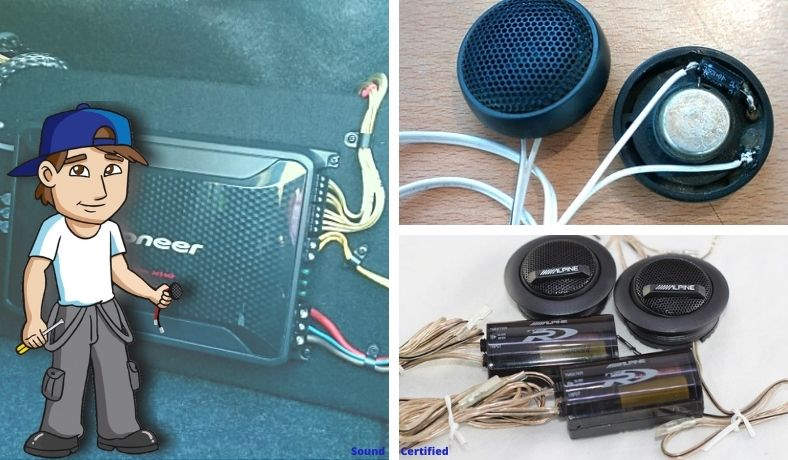Tweeters – even budget ones – can make a huge difference in your system. However, you may need to know a bit more before getting started. I’d love to help!
In this article, I’ll show you how to wire tweeters with built-in crossovers to an amp. I’ve spent hours creating clear & detailed diagrams to help, too.
I’ll cover a lot of topics that really matter:
- How to wire tweeters with built-in crossovers to an amp
- Using tweeters with an amp’s built-in crossovers
- Using your tweeters with a 2-way component speaker crossover
- Whether or not you can use tweeters with an amp driving subwoofers
Contents
How to wire tweeters with a built in crossover to an amp

The great news is that generally, car tweeters with crossovers are fairly easy to connect to amp in your current (or new) mobile audio system.
There are a few things to know first:
- Most of today’s 2 and 4 channel car amp products can handle both a 4 ohm full-range speaker and a 4Ω tweeter connected in parallel at the same time.
- It’s possible to keep the tweeter’s crossover and use an amp’s built-in crossover later (See related section below for more details).
- Not only should you never use a tweeter without a crossover, but you also shouldn’t connect a tweeter to subwoofer outputs under normal circumstances. I’ll cover that in more detail later also.
- You can replace the original tweeter crossover with a better one or use it with a 2-way component speaker crossover if you like.
How to connect tweeters with crossovers to an amp
To connect tweeters with crossovers to an amp, you’ll want to use one of the following setups as they’re the most common situations you’ll come across:
- Connect them to unused amp channels with a full-range output option: Follow the positive and negative wiring connections on the amp, being sure to match the same speaker polarity at the tweeter (either on the tweeter or marked on the external crossover for those that use an inline one).
- “Tapping off” of full-range speakers already connected to the amp: Don’t mix the polarity – for correct sound, be sure to connect the tweeter’s positive & negative speaker wiring to the same as the speakers already connected to the amp. To save time, effort, and speaker wire, if it’s convenient you can connect them in parallel at the speakers themselves. You’ll get the same audio signal there as at the amp as long as they’re full-range speakers.
- Connect them to unused amp channels: Using a full range RCA output pair from your head unit or use a pair of RCA Y-splitters at the amp to connect the 2nd pair of signal inputs to unused full-range amp channels. You’ll probably need to adjust the amp gain to a good level to match your speakers already in use.
Connecting tweeter wiring
While it’s true that a lot of tweeters come with connectors already on the wire, sometimes it’s just easier (and gives better results) if you use another way to connect the wire. Crimp connectors, for example, give professional results and won’t let you down.
In my experience, some of the connectors (usually slide tab or “spade” type) included with car tweeters are a pain in the behind to deal with. In fact, I rarely use them at all myself.
Keep reading to find out how to connect tweeter speaker wiring with professional results.
Where to install your tweeters
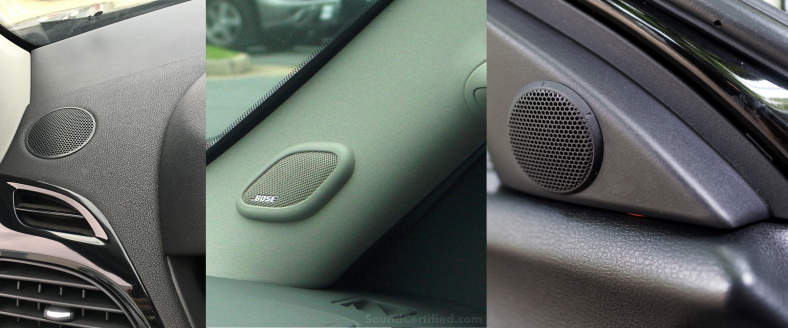
Car tweeters work best when installed where they have a good direction toward your ears. That’s because high-frequency sounds are more directional than bass, for example. As a rule, try to avoid installing them lower in your car or truck. This is one reason you see factory-installed tweeters mounted in vehicle doors or side pillars near the windshield.
It’s not always an option, but when possible it’s best to mount tweeters:
- High up near the level of your ears
- Pointing towards you
That’s because unlike subwoofers which create huge sound waves that are so big it’s hard to tell where they’re coming from, highs are directional, meaning you’ll get better tweeter performance when the sound is directed towards you and unobstructed.
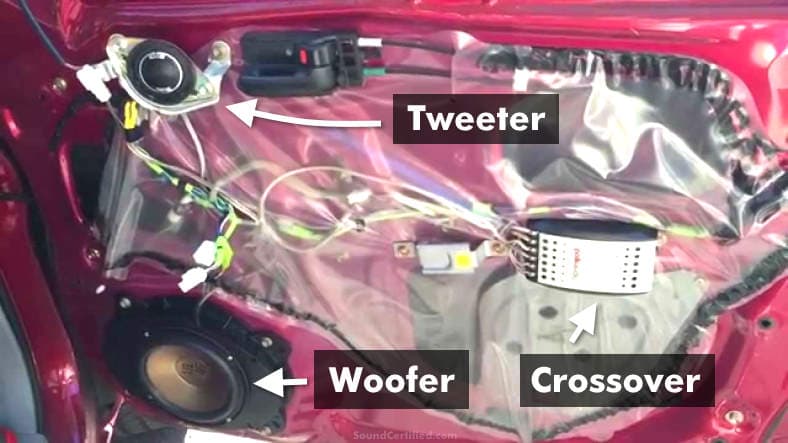
Example of upgrading factory speakers in a car door with a separate woofer, tweeter, and crossover. Note how the aftermarket tweeter is mounted in the factory bracket, held in with hot glue.
It’s one reason that factory-installed tweeters are placed high in the doors or side windshield pillars from the factory. In fact, high-end home stereo speakers are designed the same way…just that both the tweeter and woofer are placed on the same “plane” or at the same level for best results.
This is also one reason why car component speakers include tweeters designed to be mounted separately – to get the best possible sound by putting them in the best position you can find.
How to connect tweeter wires like a pro installer
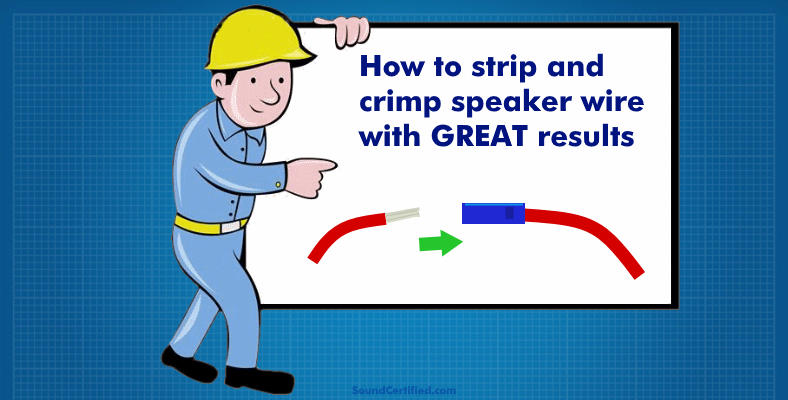
For excellent installation quality, I recommend using better connectors when possible. There are really only a few steps needed and before you know it, you’ll be great at it!
The steps are:
- Strip the speaker wire and prepare it for the connector
- Insert firmly into the (correct size) crimp connector
- Properly and firmly use a crimp tool to permanently connect the wire
Then repeat for the other wires as needed.
How to strip speaker wire
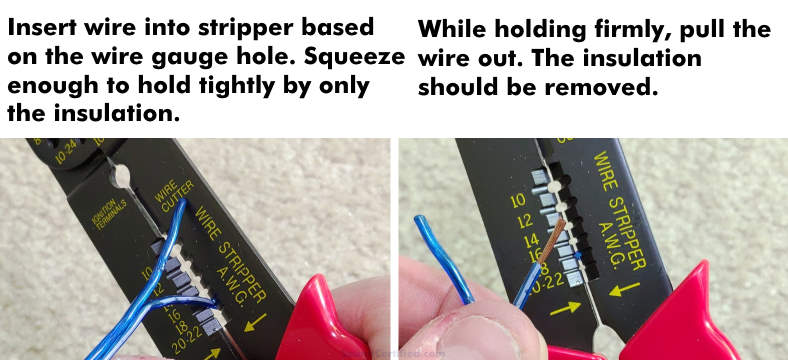
To strip speaker wire you can use a number of tools. My recommendation (and preference) is to use an affordable tool called a crimp tool. Most of these not only crimp connectors but can also cut and strip wire.
Stripping speaker wire can touchy at first and take a little bit of practice, but you’ll pick it up quickly after a few tries. The trick is to pinch only the wire’s insulation and not the wire strands themselves.
If you catch the wire inside by squeezing a stripper too hard you’ll likely break the wire and have to start over.
To strip tweeter speaker wire:
- Insert the wire in the stripper and close it carefully on the insulation. Use enough force to hold the wire in place and slightly pinch the insulation, but not enough to put force on the wire inside.
- Hold the tool & pressure in place firmly so it cannot move.
- Pull the wire. The insulation could break off and the exposed wire should remain.
What to know before stripping speaker wire the first time
Some wire types (especially smaller gauges like 20AWG, 24AWG, etc) can be harder to strip without breaking. For your first few tries, practice on some surplus wire that won’t cause you to use up what you need for your tweeter installation.
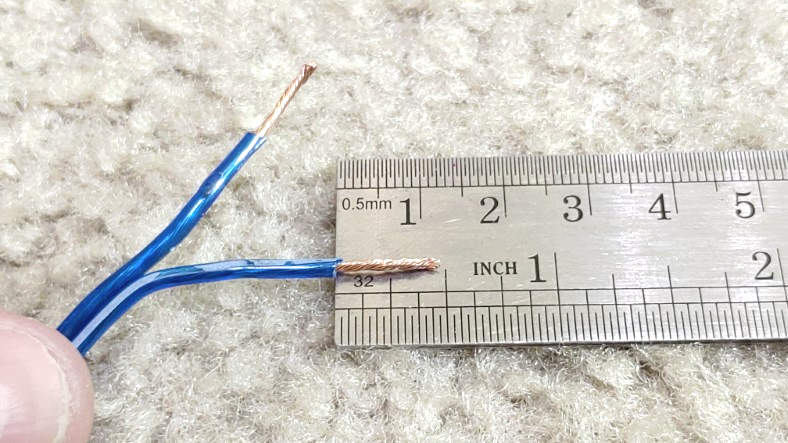
I recommend stripping enough to leave about 3/8″ to 1/2″ of bare wire exposed. For crimp connectors, 3/8″ or more should be fine.
Don’t leave an excessive amount of length because it can stick out of the connector once it’s inserted.
How to use crimp connectors with speaker wire
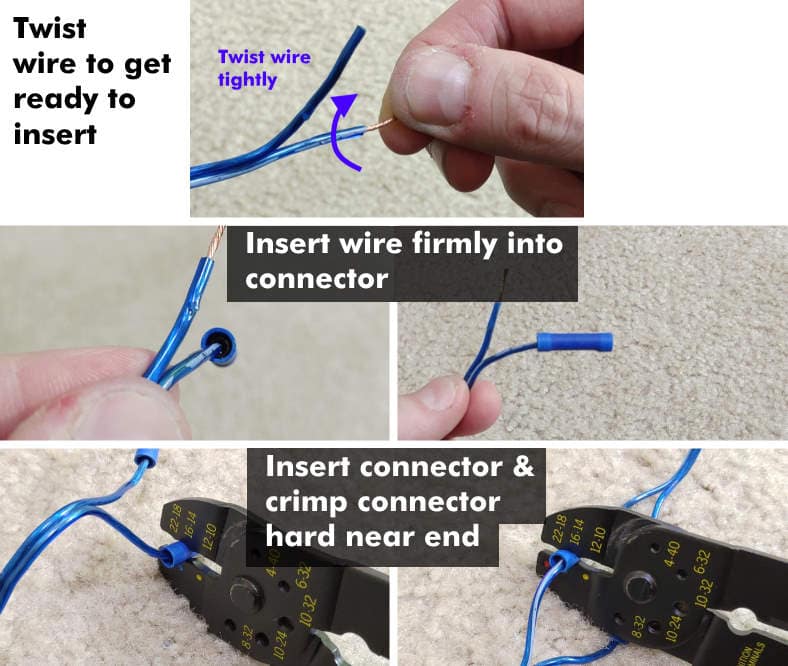
Shown: Step-by-step pictures of how to strip & connect speaker wire using crimp (“butt”) connectors. After stripping the wire, it’s time to use a crimp connector on each one and a tool to crimp them for a long-lasting connection.
Using crimp connectors with speaker wire isn’t very hard – I promise! You’ll get the hang of it after doing a handful of times.
How to crimp speaker wire properly:
- Strip the wire leaving 3/8″ to 1/2″ bare wire exposed.
- Tightly twist the wire so it can be pushed into the connector properly.
- Insert the wire into one end firmly, pushing it into the metal contact inside. Be sure to insert it fully.
- Place the connector into the crimp tool in the appropriate position in the tool, near the end of the connector.
- Crimp very hard with the tool to make an indentation in the outside of the connector. The internal metal connector should bend inward and make a permanent hold on the wire.
- Repeat the same for the other side & speaker wire.
What should it look like when you correctly connect speaker wire together?
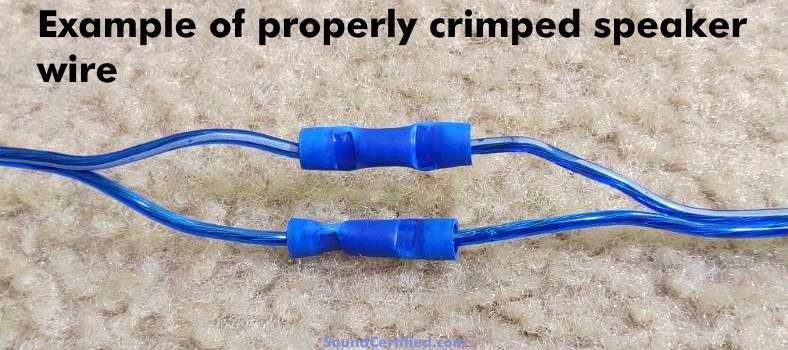
Crimp connectors, also sometimes called butt connectors, are sold in standard colors for the wire gauge sizes they can be used with. Although red is listed as fitting 18 AWG wire, I’ve been using blue butt connectors with 18 AWG speaker wire for years without problems.
You should be able to find a very small package of blue connectors (or an assortment of several sizes) for just a few dollars in general merchandise stores or auto parts stores.
Can you hook up tweeters to the same amp as a subwoofer?
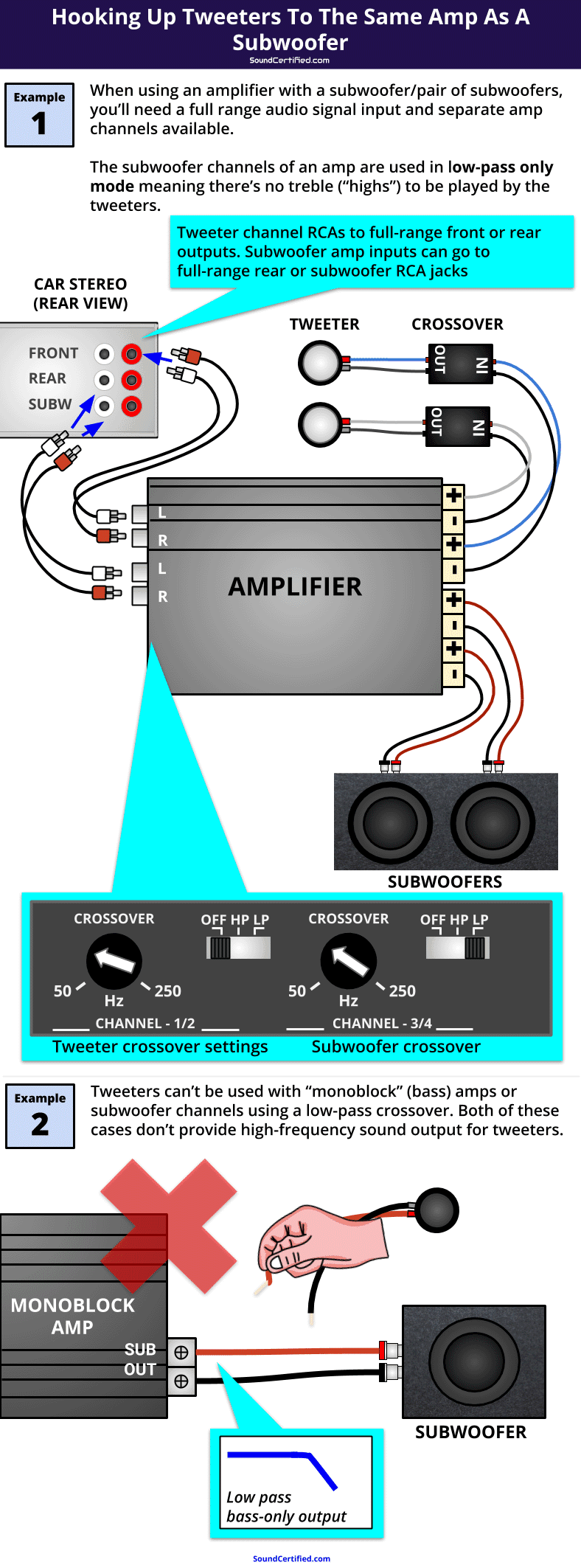
Here’s the short answer:
- You cannot use tweeters on a monoblock (bass-only) amp or a subwoofer output channel using a low-pass crossover.
- You can use tweeters with unused amplifier outputs (channels) that are full-range.
Why can’t you use tweeters on a monoblock sub amp or bass output?
You might not have known it, but nearly all monoblock (single-channel) subwoofer amps are designed only to produce bass. They’re designed just to create a lot of power and drive subwoofers with high volume. There’s no treble (highs) to drive tweeters with at all.
Additionally, using an amplifier’s channel/channels with the built-in low pass crossover means you’re doing the same there as well. For that reason you’ll have just a few options:
- For multi-channel amps, connect the tweeters to unused full-range amp channels.
- Connect the tweeters in parallel to the main speakers.
If you only have a single amp for driving the subwoofers and no unused full-range speaker outputs on your amp, there’s no way around it – you’ll have to buy another amp for the tweeters or use your head unit.
Note that head units produce a very small amount of power (about 15W or so per channel) so your tweeters won’t get anywhere near the volume or power your amplified speakers will have.
Can you use the built-in crossovers on an amp with tweeters?
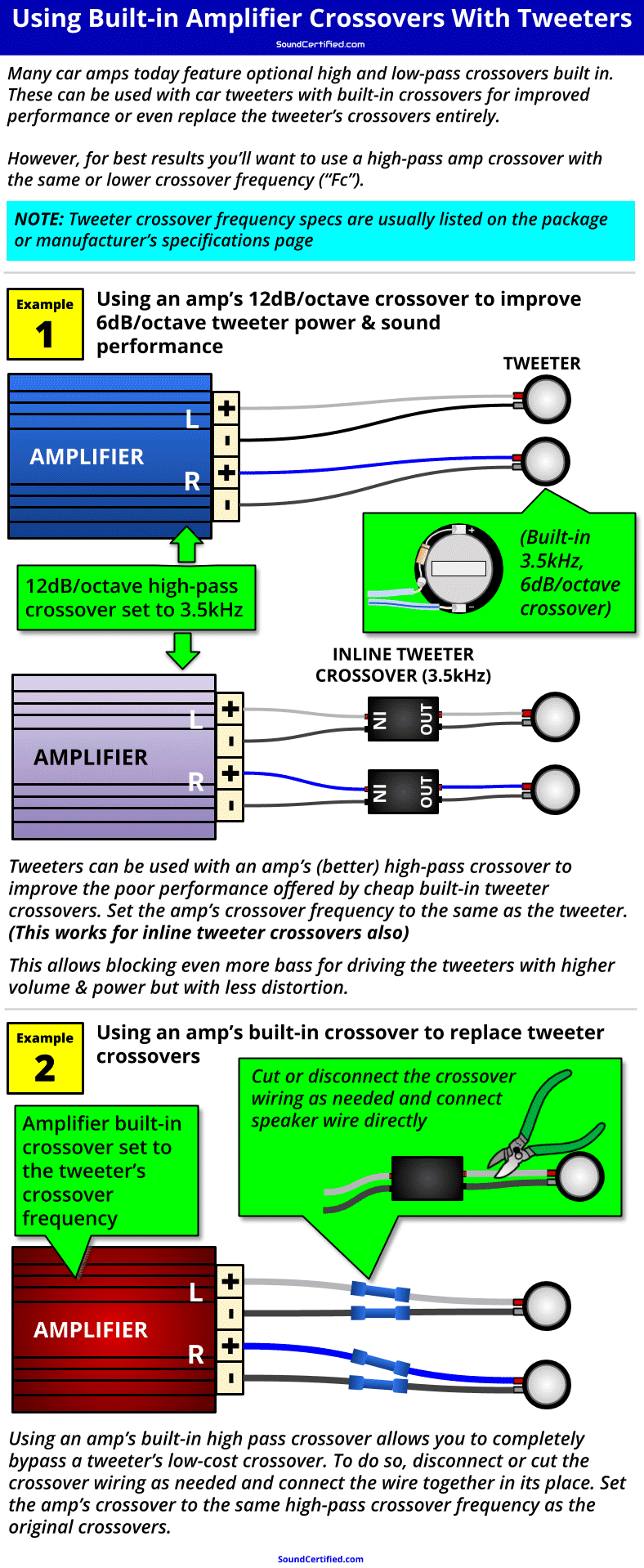
Yes, in many cases you can use an amp’s built-in crossovers with your tweeters. In some circumstances, you can even completely replace the tweeter’s crossovers this way!
Additionally, it’s one way to take advantage of your amp’s features and improve the sound.
A few examples are:
- Using the amp’s 12d/octave crossover improves (or replaces) the cheaper 6dB/octave crossover some tweeters use.
- Remove the hardwire tweeter crossover, making installation simpler.
- Improve tweeter bass blocking without the need for extra parts or work.
How to use tweezers with built-in crossovers with a 2-way crossover
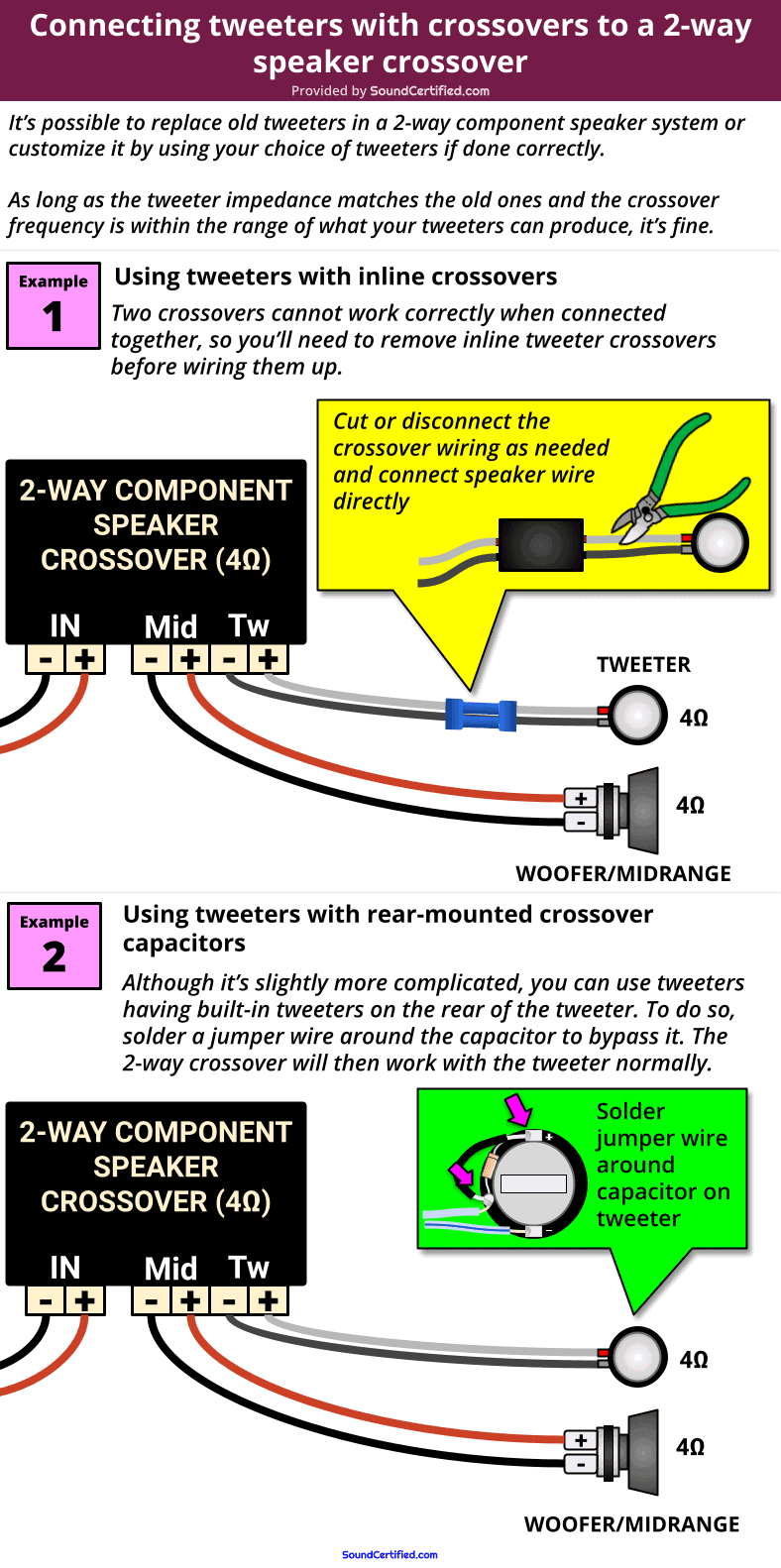
I’ve actually run into this situation myself! Let’s say you have some extra tweeters lying around or you’ve got a cool idea for your own 2-way component speaker setup.
Or maybe you’ve got a component speaker system and one of the tweeters is blown, damaged, or broken. What if you could make good use of those extra tweeters or a pair you got a great deal on?
The good news is that in most cases if the tweeter impedance matches that of the 2-way crossover this can work.
However, the most important thing here (the “showstopper” if you will) is that you don’t use the built-in tweeter crossovers. You’ll have to remove and/or bypass those.
What can’t I connect my tweeter crossovers to a 2-way component speaker crossover?
The problem here is that a speaker crossover is designed to connect directly to the speaker “load” (to the speaker impedance, or resistance if you will) directly.
Speaker and tweeter crossovers contain capacitors and inductors. No problem there, but when one crossover is connected to another it changes how they behave. This means (1) the sound will be wrong, and (2) the crossover frequencies will be very wrong.
There’s no way to “fix” that. You’ll have to be sure and remove or bypass a tweeter’s crossover before using it with a speaker crossover it wasn’t originally used with.
